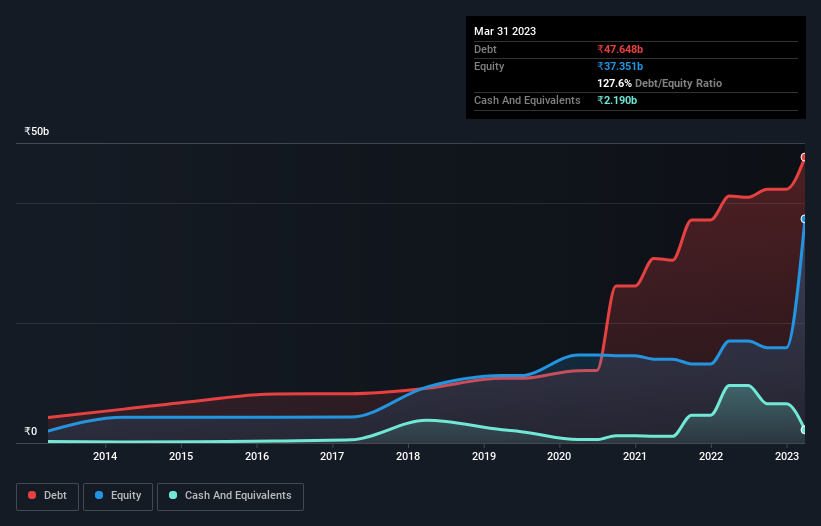We Think Swan Energy (NSE:SWANENERGY) Is Taking Some Risk With Its Debt
Some say volatility, rather than debt, is the best way to think about risk as an investor, but Warren Buffett famously said that 'Volatility is far from synonymous with risk.' When we think about how risky a company is, we always like to look at its use of debt, since debt overload can lead to ruin. Importantly, Swan Energy Limited (NSE:SWANENERGY) does carry debt. But the more important question is: how much risk is that debt creating?
Why Does Debt Bring Risk?
Debt is a tool to help businesses grow, but if a business is incapable of paying off its lenders, then it exists at their mercy. If things get really bad, the lenders can take control of the business. However, a more common (but still painful) scenario is that it has to raise new equity capital at a low price, thus permanently diluting shareholders. Of course, debt can be an important tool in businesses, particularly capital heavy businesses. The first thing to do when considering how much debt a business uses is to look at its cash and debt together.
Check out our latest analysis for Swan Energy
How Much Debt Does Swan Energy Carry?
The image below, which you can click on for greater detail, shows that at March 2023 Swan Energy had debt of ₹47.6b, up from ₹41.2b in one year. However, it does have ₹2.19b in cash offsetting this, leading to net debt of about ₹45.5b.

How Strong Is Swan Energy's Balance Sheet?
The latest balance sheet data shows that Swan Energy had liabilities of ₹22.6b due within a year, and liabilities of ₹42.3b falling due after that. Offsetting these obligations, it had cash of ₹2.19b as well as receivables valued at ₹19.2b due within 12 months. So its liabilities outweigh the sum of its cash and (near-term) receivables by ₹43.5b.
This deficit is considerable relative to its market capitalization of ₹70.2b, so it does suggest shareholders should keep an eye on Swan Energy's use of debt. Should its lenders demand that it shore up the balance sheet, shareholders would likely face severe dilution.
In order to size up a company's debt relative to its earnings, we calculate its net debt divided by its earnings before interest, tax, depreciation, and amortization (EBITDA) and its earnings before interest and tax (EBIT) divided by its interest expense (its interest cover). This way, we consider both the absolute quantum of the debt, as well as the interest rates paid on it.
Swan Energy shareholders face the double whammy of a high net debt to EBITDA ratio (19.7), and fairly weak interest coverage, since EBIT is just 0.67 times the interest expense. This means we'd consider it to have a heavy debt load. One redeeming factor for Swan Energy is that it turned last year's EBIT loss into a gain of ₹1.5b, over the last twelve months. When analysing debt levels, the balance sheet is the obvious place to start. But you can't view debt in total isolation; since Swan Energy will need earnings to service that debt. So when considering debt, it's definitely worth looking at the earnings trend. Click here for an interactive snapshot.
Finally, while the tax-man may adore accounting profits, lenders only accept cold hard cash. So it's worth checking how much of the earnings before interest and tax (EBIT) is backed by free cash flow. During the last year, Swan Energy burned a lot of cash. While investors are no doubt expecting a reversal of that situation in due course, it clearly does mean its use of debt is more risky.
Our View
On the face of it, Swan Energy's interest cover left us tentative about the stock, and its conversion of EBIT to free cash flow was no more enticing than the one empty restaurant on the busiest night of the year. Having said that, its ability to grow its EBIT isn't such a worry. Overall, it seems to us that Swan Energy's balance sheet is really quite a risk to the business. So we're almost as wary of this stock as a hungry kitten is about falling into its owner's fish pond: once bitten, twice shy, as they say. There's no doubt that we learn most about debt from the balance sheet. However, not all investment risk resides within the balance sheet - far from it. These risks can be hard to spot. Every company has them, and we've spotted 2 warning signs for Swan Energy you should know about.
Of course, if you're the type of investor who prefers buying stocks without the burden of debt, then don't hesitate to discover our exclusive list of net cash growth stocks, today.
New: Manage All Your Stock Portfolios in One Place
We've created the ultimate portfolio companion for stock investors, and it's free.
• Connect an unlimited number of Portfolios and see your total in one currency
• Be alerted to new Warning Signs or Risks via email or mobile
• Track the Fair Value of your stocks
Have feedback on this article? Concerned about the content? Get in touch with us directly. Alternatively, email editorial-team (at) simplywallst.com.
This article by Simply Wall St is general in nature. We provide commentary based on historical data and analyst forecasts only using an unbiased methodology and our articles are not intended to be financial advice. It does not constitute a recommendation to buy or sell any stock, and does not take account of your objectives, or your financial situation. We aim to bring you long-term focused analysis driven by fundamental data. Note that our analysis may not factor in the latest price-sensitive company announcements or qualitative material. Simply Wall St has no position in any stocks mentioned.
About NSEI:SWANCORP
Swan
Manufactures and markets cotton, polyester cotton, linen and viscose fabrics, and non-lycra products in India and internationally.
Solid track record with adequate balance sheet.
Market Insights
Community Narratives



